Significance of the Elms in the Play Desire Under The Elms
There are two huge elm trees on each side of the farmhouse. These elms bend their trailing branches down over the roof. They appear to protect and at the same time subdue the house. There is a sinister maternity in their aspect. They are compared to exhausted women resting their sagging breasts and hands and. hair on its roof. Thus, they symbolize the dominance of female characters. They are the symbols of maternal forces in the life of some of the characters in the play. They represent Cabot’s two former wives, who must have been exhausted women with sagging breasts. This is true especially of the second wife, Eben’s mother, whom Cabot made work to death. The green hue of the elms stands for fertility which is denied in the house since the death of Eben’s mother.
The elms are vitals symbols of nature. Abbie tells about the beat of
nature. Her seduction of Eben indicates how nature triumphs over Puritanism.
This seduction is purely a retributive act. When Abbie compares sexual desire
to the growth of the elm trees, she draws attention to them as symbols of nature,
the nature that was suppressed by Cabot. Here, the elms represent the
nature thwarted by Puritanism. Nature can be suppressed, but not for long; It
takes revenge upon its oppressors. Hence, the elms come to represent the
brooding and ultimately triumphant fate.


No comments:
Post a Comment